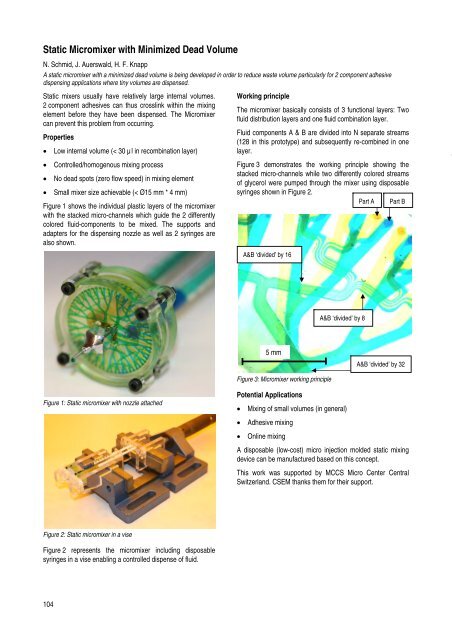CSEM Scientific and Technical Report 2008
CSEM Scientific and Technical Report 2008
CSEM Scientific and Technical Report 2008
You also want an ePaper? Increase the reach of your titles
YUMPU automatically turns print PDFs into web optimized ePapers that Google loves.
Static Micromixer with Minimized Dead Volume<br />
N. Schmid, J. Auerswald, H. F. Knapp<br />
A static micromixer with a minimized dead volume is being developed in order to reduce waste volume particularly for 2 component adhesive<br />
dispensing applications where tiny volumes are dispensed.<br />
Static mixers usually have relatively large internal volumes.<br />
2 component adhesives can thus crosslink within the mixing<br />
element before they have been dispensed. The Micromixer<br />
can prevent this problem from occurring.<br />
Properties<br />
• Low internal volume (< 30 µl in recombination layer)<br />
• Controlled/homogenous mixing process<br />
• No dead spots (zero flow speed) in mixing element<br />
• Small mixer size achievable (< Ø15 mm * 4 mm)<br />
Figure 1 shows the individual plastic layers of the micromixer<br />
with the stacked micro-channels which guide the 2 differently<br />
colored fluid-components to be mixed. The supports <strong>and</strong><br />
adapters for the dispensing nozzle as well as 2 syringes are<br />
also shown.<br />
Figure 1: Static micromixer with nozzle attached<br />
Figure 2: Static micromixer in a vise<br />
Figure 2 represents the micromixer including disposable<br />
syringes in a vise enabling a controlled dispense of fluid.<br />
104<br />
Working principle<br />
The micromixer basically consists of 3 functional layers: Two<br />
fluid distribution layers <strong>and</strong> one fluid combination layer.<br />
Fluid components A & B are divided into N separate streams<br />
(128 in this prototype) <strong>and</strong> subsequently re-combined in one<br />
layer.<br />
Figure 3 demonstrates the working principle showing the<br />
stacked micro-channels while two differently colored streams<br />
of glycerol were pumped through the mixer using disposable<br />
syringes shown in Figure 2.<br />
Part A Part B<br />
A&B ‘divided’ by 16<br />
5 mm<br />
Figure 3: Micromixer working principle<br />
Potential Applications<br />
• Mixing of small volumes (in general)<br />
• Adhesive mixing<br />
A&B ‘divided’ by 8<br />
A&B ‘divided’ by 32<br />
• Online mixing<br />
A disposable (low-cost) micro injection molded static mixing<br />
device can be manufactured based on this concept.<br />
This work was supported by MCCS Micro Center Central<br />
Switzerl<strong>and</strong>. <strong>CSEM</strong> thanks them for their support.








